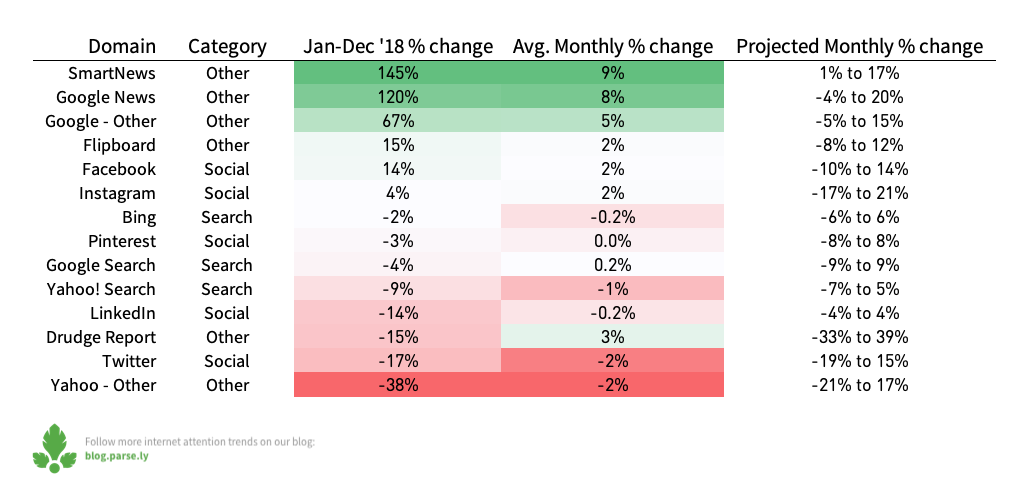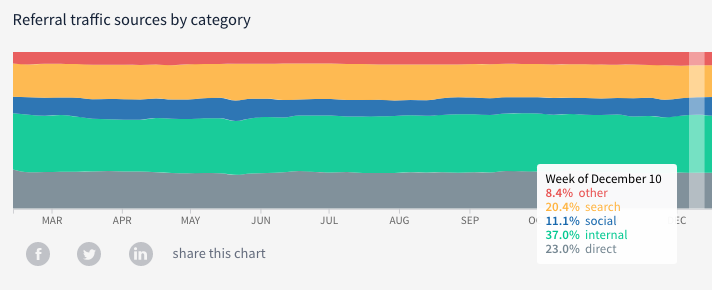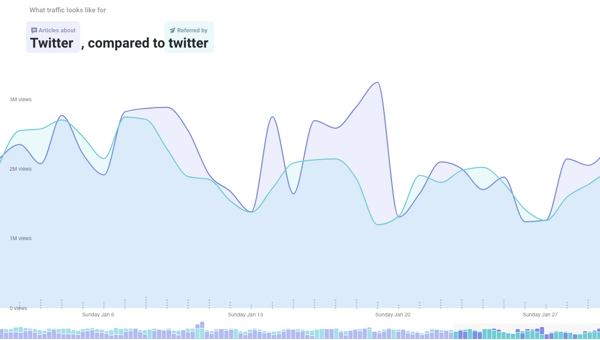Predicting sources of traffic to content in 2019

Data has a habit of giving us advance signals about particular trends.It shouts, “Hey, something big is happening.” Like when we saw Facebook decline for six months before they announced official changes to their newsfeed.
Some of those trends jump out more than others. Wouldn’t it be great to predict how reliable those trends are? Things change fast online. I would want to be sure about a trend before investing resources in chasing it.
Presenting: Predictions based on rate of change
So get ready for a deep dive into how platforms have changed over the last year looking not only at the sheer amount of traffic that changes, but how quickly it changes. Platforms that look promising (SmartNews, and yes, still Flipboard), platforms that look like they’re slipping (Twitter), and platforms that cannot make up their damn mind (looking at you, Google).
I want to distinguish reliable growth versus shiny growth. If it’s reliable, I want to know what is driving that growth. Changes in reader behavior versus changes in product both need to be identified and understood. And you need to know if those changes affect the content you produce and audience you work to reach.
I’m going to spend this post, the first in a two-part installment, laying out which platforms we should probably keep an eye on this year. In the next post, we’ll dive into whether specific types of content are working on these platforms.
Here’s the high level summary, and read on to learn more about my rankings for each.

First, the big picture:
Let’s start ourselves off on the right foot: on any given week in 2018, internal referrals, meaning someone that came to a second (or third, or thirtieth) page within your site, comprised over 35% of traffic. People who come to sites do keep reading. Internal referrals drove more traffic than direct referrals, and more than any external referrals (search, social, or other).
The people making content now own so much of that traffic, a fact easy to forget with the drama of Facebook and Google playing out in the news.
Direct referrals are also up a smidge. In my four years experience working directly with Parse.ly-powered sites, email traffic is usually a good chunk of that. With a heavy focus on newsletters and subscriptions this year, this should be validating.

Okay, those are the people you’ve already convinced to engage with your work. What about where you should go to find new audiences, meeting them where they are already engaging? For each category and referral below, I’ve broken them down by looking at two stats. First, the total annual increase or decrease by total volume of views referred to our network. Second, I looked at the average monthly increase or decrease, plus the standard deviation.
OTHER REFERRERS
Annual Change: +21% | Average Monthly Change: +3%, +/- 17%

Let’s start with Other referrers. We classify “other” as any identifiable, external site that is neither search nor social. It’s not the largest, but is the most experimental. At +21% YoY, it is the fastest changing category that sends traffic to our network. You can expect these news aggregators and other referral sources to change anywhere from -14% to +20% monthly.
Get on board with these:
SmartNews. If you’ve been lurking around any nerdy news Slack channels, or audience-focused Facebook groups, you’ve probably seen this name making a splash! Not the largest external referrer by a long shot, but is up 145% YoY, and growing at an average of 9% MoM, with a steady trajectory upward. SmartNews is the most reliably growing external referrer. In a good month you might see your traffic from SmartNews up to +17%, but even a “low” month will generate +1% growth. Big ???? here — get on board.
Flipboard. Hey kiddo! Flipboard still shows growth, over two years after we first saw them really show up towards the top of our referral lists. They’re trucking along! Up 15% YoY, with fairly reliable growth MoM, ??
Google News. Google News is very likely still on a path to grow, at least in the short term (short term for me is a few months, not like…by this weekend). We’ve written about Google News referrals before, but holy moly, as the largest domain by volume in this category, 120% YoY growth is nothing to scoff at. It’s on the bigger side, but expect monthly changes anywhere from -4% to 20%.
Google Other. All the ways Google serves you content that’s not search and also not Google News. Confusing? Yep. I have some thoughts as to why, but it’s the second largest domain in this category, so we’ll continue watching this one closely. The biggest changes here happened in the latter half of 2018, falling on its face a bit in August, but then climbing fast with the launch of Google Discover and other Google content recommendation products. It’s clear that Google wants this to work, and is making it easier for readers to find content outside of a specific platform. We expect it to continue, but here too, don’t bank on identical growth a year from now (at least not yet).
But keep an eye on these:
Yahoo News. Yahoo News is down -38%, but MoM changes vary more than other sources in this platform. It’s on the lower end of top referrers in this category, so for some, this might not make a huge dent (or it might make a huge one). I’m not going to say “don’t bother,” though: Yahoo non-search traffic could change anywhere from -21% to +17% MoM, which indicates its potential to rebound.
If you’re reading this, I assume I don’t need to tell you that Drudge Report is the least reliable traffic source on the internet. Even when Facebook fell, it fell reliably. But in case you do need to hear this: drudgereport.com is down -15% YoY, and MoM change could range anywhere from +39% to -33%, generously. At its best, it grew +99%, at its worst, it fell -43%. With this kind of fluctuation, I don’t particularly care why. If it works for you, don’t look a gift horse in the mouth. But don’t bother investing much in in this horse either. Moving on.
SOCIAL REFERRERS
Annual Change: +9% | Avg. Monthly Change: -0.6%, +/- 13%
Social doesn’t change quite at the same pace as Other referrals, but it’s not far behind. On the whole, it’s up 9% YoY largely thanks to Facebook. But monthly change on any social platform can range averages -1%, give or take 13% (compared to -14% to +20% from the Other category). I don’t know if you needed further proof that social is a fickle beast, but there you have it.
That said, I hope that sets a new standard. Social platforms, big and small, can be expected to change anywhere from -14% to +12% MoM. That’s the norm.

Specifically:
Facebook. Not new, but a new perspective. After all we’ve been through, Facebook traffic is up 14% this year. It’s been a reliably growing source of traffic August onward. The beginning of the year was rocky though, and it shows: Facebook can still be expected to change 2% +/-12% MoM. I still give this a vote of cautious confidence though because of the smooth growth five months in a row. It might surprise you, but its MoM change is still within what’s “normal” for social media, and smooth growth is more indicative of real, engaged audiences, not product changes that are out of our hands. Perhaps the their string of bad decisions is making them realize they need quality content again?
Let’s zoom in on that graph again, this time without Facebook.

Instagram. I could say many of the same things about Instagram, considering its ownership. The social app is up 4% YoY, but is the least reliable social platform: in a good month, you might see 21% growth; other months, you lost -17%. When it works, it works really well. I suspect that these results go beyond product changes at Instagram; I know many newsrooms who have experimented with a niche audience on IG and succeeded. Therefore, I can’t help but wonder if this is a platform that requires a bit more audience engagement efforts. And for that reason, it is the platform I’m most excited about to look at specific audiences and content for (stay tuned for part II of this post!).
Twitter. From January to April, Twitter referrals dropped -11%. Things started to rebound until July, and then began to slip back down. YoY, Twitter is down -17%. However, it has the highest deviation in this category, meaning it’s possible that it would rebound again. This is another platform we’ll be focusing on heavily in Part 2, as we’ve found in the past that Twitter, like Instagram, may resonate with particular audiences, and not others. There is also a question of perception of Twitter’s influence despite it’s actual size as a referrals. There are more views to articles about Twitter than views from people find articles and stories on Twitter.

LinkedIn. Talk about a mainstay. Articles have floated LinkedIn as a potential foil to Facebook, but this platform is not one in search of the limelight. It’s down -14% YoY, but was on the rise until August. In many ways, this trend was a lot like Twitter’s, where any traffic gained from this platform was a wash by the end of the year. But negative delta aside, it deviates the least out of this group with average monthly changes just below 0%, give or take 4%
Reddit. Reddit really took a beating this year, but this observation comes with a big caveat. The Reddit app (like many social apps in years before) does not send referral data, meaning the traffic that comes from it shows as direct (some people refer to this as “dark social“). Reddit is down -52% YoY, and unfortunately, changes less MoM than others, meaning it’s likely to continue downward. Perhaps their app usage has increased, which is likely given other mobile trends. We left it off the main chart because of the unknown quantity of app traffic.
I want to point out something specific to this part of my analysis, because I imagine this is something social media, audience engagement, and marketers struggle with too: I was very tempted to give Instagram, Twitter, and LinkedIn more positive trajectories: “They’re not doing so hot right now, but social media changes more than other platforms! If you’re not on social media, do you even exist??” Those perceptions are real.
But, consider that a combination of 1) the variability of MoM change across all social platforms, 2) downward trends in the last half of the year in Instagram, LinkedIn, and Twitter. Trust the numbers for what they are. But they are also what prompted us to dive deeper into the nuance of each platform by what specifically what kinds of audiences are engaging with. Stay tuned for Part 2.
SEARCH REFERRERS
Annual Change: -4% | Avg. Monthly Change: -0.3%, +/- 7%
We’ve written a bunch about search over the last year, and for good reason. Google dominates this space, and on any given day will be around half of our network’s external traffic and a quarter of overall traffic. Our past study of GQSB being as prevalent as it is could suggest that content recommendations to Google’s various not-News and not-Search products are being curated based on search results. These content recs are a bit of a blackbox, but if that is true, it means your SEO game will matter for more than just rankings alone.
I’ll briefly review Google, Bing, and Yahoo!, but unlike social refs, search refs are pretty… boring. And that is probably a good thing for now. On average, each platform changes at around .5% per month, +/- 7%.

Google. Now, +/-7% is a big deal when you’re talking about a quarter of total traffic. The behemoth is actually down -4% YoY, and varies the greatest of all search platforms, at +/-9%. That puts it in the red as far as “normal” for search refs go, but that’s also what calls for a practical outlook here. Google dominates all search traffic, it’s not going anywhere anytime soon. It doesn’t matter what is “normal” for search refs when most of your search refs are Google. Therefore, expect Google to give or take +/-9% any given month, usually dependent on major breaking news stories.
Now for the little guys!
Bing. Bing’s changed the least YoY, only down -2%, with the least amount of change MoM. If you get traffic from Bing, don’t expect any surprises (that might be good news for you). ??
Yahoo! Yahoo is the smallest of the three, and it is down the hardest, at -9% YoY. Its change was also slow and steady, and I do expect this trend to continue in this direction, so ?? for that reason. Now: Yahoo’s product portfolio is a diverse one. It’s possible that this decline in Yahoo search is in favor of other products, like the additional content recommendations Google has been experimenting with.
And that wraps Part I of this installment of referral traffic predictions. Remember, even with the best data – this post is still probably going to get a few predictions wrong. As Google non-search traffic has shown us, platforms experiment with how they get readers to engage all the time. We’re going to dig into what’s happening right now, but we should all fully acknowledge the possibility that a product change in the next few months could swing your traffic in a new direction. Take these with a grain of salt, and not gospel.
In the meantime, I want you to experiment with platforms and crush it. I want you experiment when the odds are stacked against you, and still crush it. I’m a skeptical optimist. I don’t always think things are going to work out. But I really, really want them to, and I think our best chances start with understanding this data.

Do you have an interesting story about success with any of these referral sources that you’d like to share? Reach out, we’d love to hear it.
Want data like this sent to you as soon as we publish it? Part II will be coming soon, make sure to sign up for our data newsletter in the form below to get it!